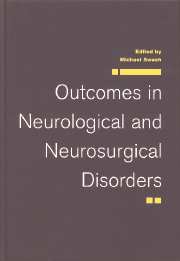Book contents
- Frontmatter
- Contents
- Contributors
- Preface
- I Introduction
- 1 The measurement of outcomes of health care
- 2 Definition and measurement of outcome
- 3 Cost-benefit analysis
- 4 Imaging of the nervous system
- II Vascular disorders
- III Trauma to the central nervous system
- IV Tumours
- V Degenerative disease
- VI Infections of the central nervous system
- VII Epilepsy, coma and other syndromes
- VIII Surgery for movement disorders and pain
- IX Rehabilitation
- Index
3 - Cost-benefit analysis
from I - Introduction
Published online by Cambridge University Press: 02 December 2009
- Frontmatter
- Contents
- Contributors
- Preface
- I Introduction
- 1 The measurement of outcomes of health care
- 2 Definition and measurement of outcome
- 3 Cost-benefit analysis
- 4 Imaging of the nervous system
- II Vascular disorders
- III Trauma to the central nervous system
- IV Tumours
- V Degenerative disease
- VI Infections of the central nervous system
- VII Epilepsy, coma and other syndromes
- VIII Surgery for movement disorders and pain
- IX Rehabilitation
- Index
Summary
Introduction
When applied to health and health services, the purpose of cost-benefit analysis is to identify and provide those services that have the largest effects on health (Drummond 1980; Drummond et al. 1997; Mooney et al. 1986; Le Grand et al. 1992). This means that we should not provide services that have no useful effects, or those that are likely to be damaging to health. Many services can do good, but there is also a risk that they will do harm. One important criterion is that the expected benefit exceeds the expected harm by a sufficient margin to justify taking the risk.
Applying cost-benefit analysis also means that we need to avoid those interventions that do some good, but not enough to justify inclusion in the programme. This is where the difficult decisions lie, since we know that services that are medically useful will be denied to patients. However, the justification for the cost-benefit approach is that it allows us to choose to spend the health service resource to better effect.
Cost-benefit analysis provides a framework for choices. It is not a set of rules that makes choices. There are two reasons for this. First, the techniques are not sufficiently developed for simple decision rules to be applied. Second, cost-benefit analysis can only be as good as the data that are used. Often these data are not complete, and assumptions and estimates have to be used. It is better to see cost-benefit analysis as a useful way of thinking about problems rather than as a set of decision rules. Cost-benefit analysis is about health.
- Type
- Chapter
- Information
- Outcomes in Neurological and Neurosurgical Disorders , pp. 35 - 46Publisher: Cambridge University PressPrint publication year: 1998

